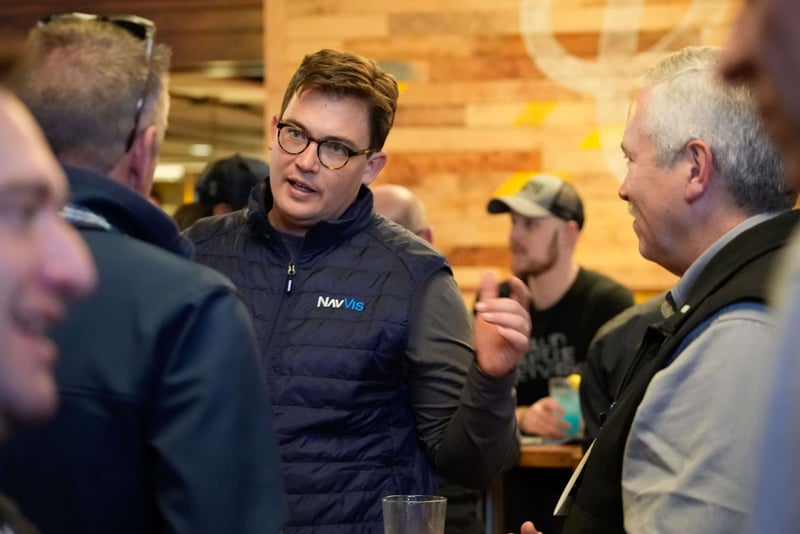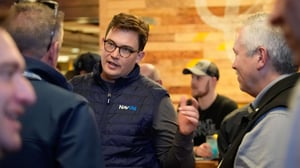Meet Evan McPhee, CEO of the NavVis US subsidiary. Find out about his experience managing a high-tech business, how we foster a culture of creativity, and more.
1. What experience do you have in managing high-tech businesses?
I was a junior employee at Facebook from 2012 to 2014, where I learned from some of the best about selling to large customers. Since 2016, I have run the U.S. office at NavVis. At first, “running the US office” was a bit misleading as I was also the only employee. Over the past seven years, however, we have grown as a team of 30 people here in the U.S. We are now making millions of dollars in bookings every year selling to a wide variety of customers across the USA.

2. How do you stay current with advancements and trends in the technology industry?
I spend a lot of time learning about our industry, competitors, and key developments in our industry and in the broader tech industry. This includes going to key industry trade shows, developing my network to keep my ear to the ground, and following industry publications and forums to stay up to date. I also, of course, spend a ton of time working with our customers who have their fingers on the pulse of many different sub-verticals in our industry. Also, I spend a bit more time on Twitter than what is probably considered healthy.
3. Can you give us an example of a successful project or initiative you led in a high-tech business like NavVis?
At the beginning of the U.S. chapter at NavVis, our technology wasn’t nearly as impressive as it is now. I didn't have a deep understanding of the reality capture world at the time- I was starting out in this industry and didn’t have a real network yet. Our first commercial hardware product, NavVis M3, was an expensive product that we sold in a subscription model. Taking the first step in building my network and getting this product in front of people was a giant first step.
The NavVis M3 was an innovative mobile scanner, but it was also very large and very expensive and had real limitations- for instance, it could only scan on flat surfaces, not on ramps or slopes or upstairs. You couldn’t fly with it as checked baggage and needed to ship it ahead of you via ground freight for sales demos. Proving the value of NavVis M3 to our first customers was a real challenge, but since then we released products that over time became significantly more flexible, affordable, and portable. We learned a ton with these first products that have helped us build a strong foundation as our technology has improved to where it is today. Of course, NavVis VLX 3 is way easier to sell than NavVis M3 ever was.
4. How do you approach identifying and addressing potential risks or challenges in a high-tech business?
We’ve come a long way as a company in the US and worldwide, but of course, we need to tackle big challenges to keep growing the way that we want to grow. I have a few key principles on this topic, but one that’s come up recently is the one I’ve borrowed from Jeff Bezos - we need to have “strong convictions, loosely held.” We need to have crazy strong opinions about our solutions and their impact on our customers so that we can move quickly, but we also need to recognize when evidence suggests that we need to change these opinions. Of course, this is a tricky balancing act.
5. How do you prioritize and manage competing demands and projects in a high-tech business?
This is an everyday challenge- the main thing I focus on here is avoiding the trap of “firefighting” every day. It can be tempting to address the urgent items that pop up every day, but that can lead to a lack of focus on longer-term goals that may be very important but not urgent on any particular day.
6. Can you describe a situation where you had to make a difficult decision in a high-tech business, and how you approached it?
I’ll need to leave names and details off of this one, but we had an early customer back in the M3 days who had an issue where one of their scanning technicians was out sick, and hence, a high-priority project was at risk. While we had a ton of high-priority topics of our own to work on at the time, I decided to go and perform the scan myself to make sure that this project went well for our customer. They’ve been one of our longest and best customers for many years now. While we’ve grown significantly, we still try to go above and beyond for our customers wherever we can.
7. How do you foster a culture of innovation and creativity in a high-tech business?
We try to tackle this from many angles, but I think the most important is that we empower people at all levels of our organization to think up and try out new ideas. Innovation isn’t a top-down process- executives don’t have all the good ideas, and many great product and process innovations have come out of our teams in the field trying new things.
8. Can you discuss a time when you had to navigate a change in technology or market conditions in a high-tech business?
Like many in our industry, we had our challenges in 2020 with the early stages of the pandemic. In March 2020, we were just about to launch the first VLX into the market, but hadn’t quite done so. That meant that our very first VLX demos were done in the early days of a global pandemic that no one really understood. We found creative ways to do demos outside, in low density areas, and ship our demo devices around the country to ensure that we made that launch a success. Of course, the continuing success of our mobile IMMS solutions is a testament to how well we did.
9. How do you manage and lead cross-functional teams in a high-tech business?
Cross functional teams are really required in our line of work- we have a bunch of different areas of expertise necessary to sell our solutions, support them, and to dig into the technical issues with customers. I think setting up the right framework for collaboration and letting smart people on your team problem-solve within those processes and structures is the best path to success on this topic.
10. What strategies do you use to evaluate and measure the performance of a high-tech business?
Digging into the metrics that matter is crucial in any business- ours is no different. While dollars in the door are important, in many ways those dollars are the output derived from a variety of input metrics that are predictive of our success. Identifying these key metrics which can predict future success and remaining laser focused on them is extremely important to keep our business growing.
The Insider Report was brought to you by Lidar News. Follow along as they give an inside look at the NavVis team!

